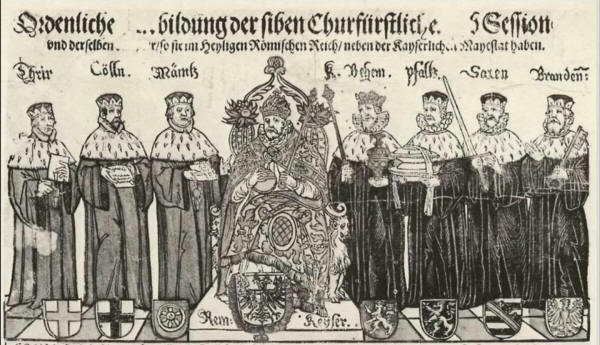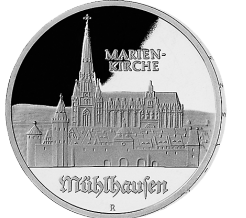Heinrich Schütz,
Da pacem domine (Peace is what we need, o Lord), SWV 465
The official music for the Mühlhausen Kurfürstentag of 1627
As a 'Chapel master' of the Court of the Elector of Saxony, Heinrich Schütz was responsible for all 'official' music: both for the Church and the Court. BTW: Very often Church and Court 'merged'. During the Thirty Years War (1618-1648) the Elector of Saxony tried to mediate although he was Protestant. One of the last possibilities to avoid a 'total war' in Germany, was the Mühlhausen Kurfürstentag of october/november 1627. There the Emperor of the Holy Roman Empire, Ferdinand of Austria (Habsburg), met with the most powerful German Princes, the Prince-Electors. On the image below you see the seven Electors around 'their Lord and Master', the Emperor. From left-to-right: Trier, Köln (Cologne), Mainz, Bohemia, Pfaltz (Palatine), Sachsen, Brandenburg. In 1623 positions had changed: The war had begun and the King of Bohemia and the Elector Palatine got into trouble (protestant rebellion). Bayern claimed and acquired the Elector Palatine's seat. These are the six present in Mühlhausen 1627 with the Emperor, albeit only one Elector Prince 'in person': the arch-bisshop of Mainz. The other five were represented by ambassadors.

Mühlhausen was a Freie
Reichsstadt (republican self-ruled membercity of the Holy Roman
Empire). Schütz provided the music for the
event: 'table-music', ballets, fireworks &cetera. No single note of
this music is transmitted. What we have though, is the official
music played at the arrival of the Emperor and the Princes, or at least: at
a Church Service where they were present, most likely at the beginning of
the 'Political Summit' that was going to decide about war and peace in the
German lands (and the rest of Central and Northern Europe). Many practical
arrangements of 'living together while religiously separated' were at the
agenda. One of the most tricky issues: the roman-catholic convents and
monasteries in protestant areas. If one could reach an agreement, peace, or at
least a cease-fire might be possible.

The music performed at the Opening-Ceremony of this Kurfürstentag is extant although the original autograph was destroyed in the Second World War (Library at Königsberg/Kaliningrad). Fortunately Philippe Spitta had published the score in his Schütz Edition. And H. Müller the Latin/German dedication in his 'Gesammelte Briefe und Stücke (1931). - see below.
Also extant is the 'Register of those persons from the [company of ] musicians who could be taken along to Mühlhausen both for attendance on days with church services and at table'. This list contains the names of 18 musicians.
And Schütz' dedication of the piece (in Latin) + instruction about the way the motet should be performed. [I copied these below].
Taken together we can imagine the scene: The church will have been the 'Marienkirche' (St. Mary's). At the beginning of the Service Schütz's motet is performed. There are two choirs, of which choir I should consist of five viola's ((da gamba) and as Schütz suggests: one part or maximum two should also be performed vocaliter (sung), but 'quietly' [submisse]. This choir sings, the Old Latin prayer for peace:
Da pacem, Domine, in diebus nostris
Quia non est alius
Qui pugnet pro nobis
Nisi tu Deus noster.
Schütz suggests that the second choir could be placed elsewhere in the church, quite a normal practice in those days. Remember Schütz is a student of Gabrieli (poly-choral music in the San Marco). Schütz-biographer, Martin Gregor-Dellin, - but he is a romantic - even suggests: in the Hall of the Church, hailing the 'arrival' of the 'men in power', the Princes (or their Representatives) and the Emperor. They should sing with full voice but gracefully:
Vivat Moguntinus, - [the Prince or his Ambassador] from Mainz
Vivat Coloniensis, -
from Cologne
Vivat Trevirensis, - from Trier
Vivant tria fundamina pacis.
(= the three Founders of Peace) - These three were
Elector-archbishops. The others were secular princes.
Vivat Ferdinandus, Caesar
invictissimus. - the unconquered Emperor Ferdinand,
Vivat Saxo, -
from Saxony
Vivat
Bavarus, - from Bavaria
Vivat Brandenburgicus - from Brandenburg
Vivant
tria tutamina pacis. (= the three Peace keepers)
Vivat
Ferdinandus, Caesar invictissimus...
Either way, the impact will have been quite impressive: One hears the continuous prayer for peace, embedded in the sound of the consort of violas-da-gamba, a 'humane' sonority which has no equal in the modern instrumentarium, but it is coming from 'far', from the Choir of the Church, where the Altar is, while the festive 'vivats' fill the Church, perhaps enforced by the sound of trumpets/trombones. In the end however only the prayer remains, because in the final part Choir I and II join forces both singing/praying: Da pacem domine, in diebus nostris.
In this video I tried to evoke this using a 'text-overlay' while Cantus Cölln and Musica Fiata perform this motet. In my humble opinion Heinrich Schütz also tried to deliver a message to the 'men in power', of course without transgressing boundaries (he is only a 'civil servant ' of/to the Elector). Just listen, and feel it.
summer 2017, Dick Wursten ( https://dick.wursten.be | https://bach.wursten.be )
NOTE:
DEDICATION (original below)
[in Latin] This text closely mirrors the text of the motet.
Grant peace, Lord. And long live Ferdinand, the most unconquerable emperor: the most holy men of Mainz, Trier, Cologne: the most glorious men of Bavaria, Saxony, Brandenburg: the Electors of the Holy Roman Empire—seven most august men, gods of our Germany, blessed tutelary deities, bringers of peace! Heinrich Schütz, Kapellmeister of the Most Serene Elector of Saxony, wishes, and expresses his wish with nine voices, that these men may, with the protection and help of God most high and everlasting, with the Temple of Janus firmly closed (i.e. there is no war, DW), establish and secure altars of peace and liberty in imperial Mühlhausen.
[in German] Ordinance of this piece:
Primus Chorus for five voices [5.
Vocum], performed by five viols, to which one or two voices can
sing quietly [submissè]:
Secundus Chorus is for four singers
which articulate the text with elegant grace [mit feiner gratiâ], and
otherwise sing fully. It is also possible to have this choir set up
separately from the first.
ORIGINAL TEXT of the Dedication (in manuscript - the owner before the Second World War was the University Library of Königsberg; lost since then!):
H.Schütz, Gesammelte Briefe und Stücke (ed. E.H. Müller, Regensburg 1931), pp 87-88
Da Pacem Domine pp. Et vivat Fertinantus Caesar lnvictissimus: Moguntinus, Trevirensis, Coloniensis sacratissimi: Bavarus, Saxo. Branteburgicus Gloriosissimi: Sacri Romani lmperii Electores - Septemviri Augustissimi, Germaniae nostrae DI. Tutelares felices, pacifici!
qui ut
Dei summi et Sempiterni praesitio et Auxilio Iani
Templo fortiter clauso pacis et libertatis Aras in Imperiali Mülhusa
excitent et stabiliant, vovet, et Votum Vocibus novem repraesentat
Heinricus Sagiitarius,
Serenissimi Electoris Saxoniae Capellae Magistro.
Ortinantz dieses Stückes:
Primus
chorus 5. Vocum, kan von 5. Violen bestellet, und eine oder zwey Stimmen
Submissè darzu gesungen werden:
Secuntus Chorus
gehöret Vor 4. Sänger, welche die Wort mit feiner gratiâ aussprechen, und
sonst starck singen, und kan dieser Chor Von dem ersten absonderlich
gestellet werden.